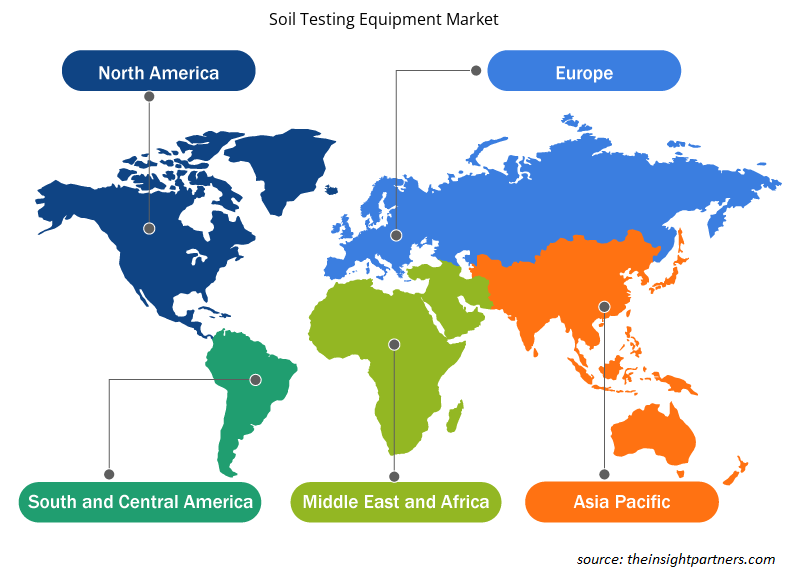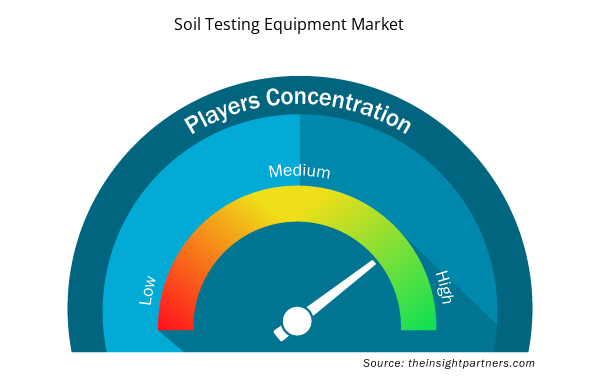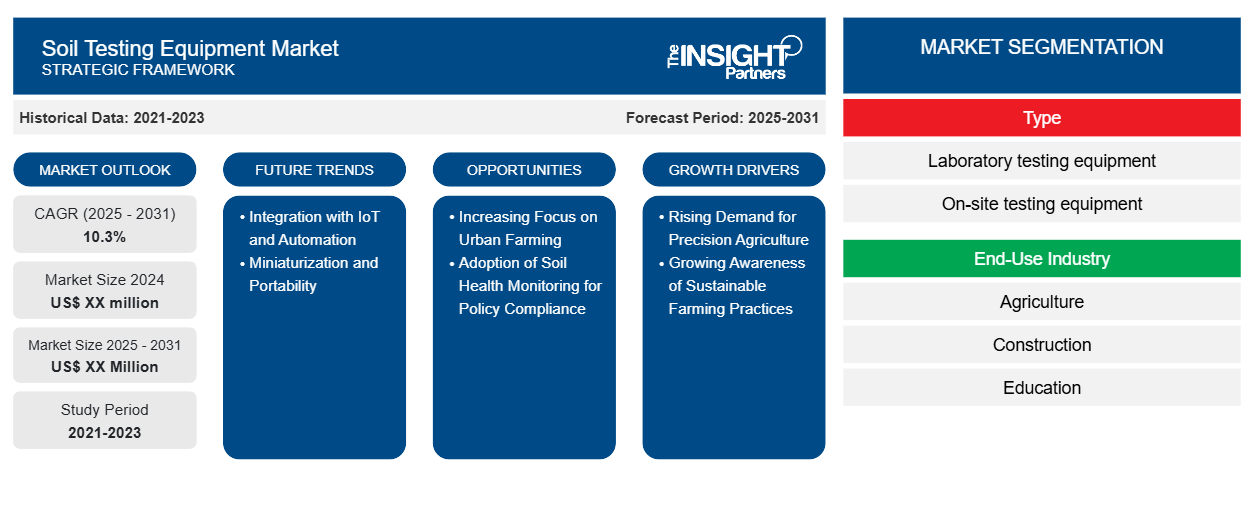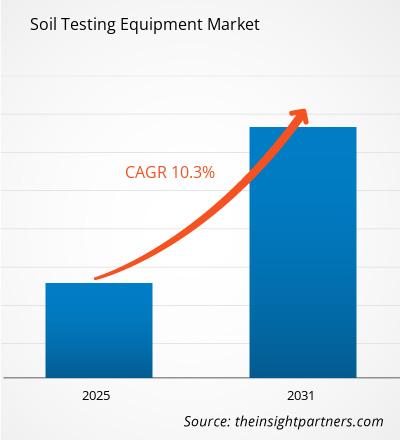Si prevede che il mercato delle apparecchiature per l'analisi del suolo registrerà un CAGR del 10,3% dal 2024 al 2031, con una dimensione di mercato in espansione da XX milioni di dollari nel 2024 a XX milioni di dollari entro il 2031.
Il report è segmentato per Tipo (Apparecchiature per prove di laboratorio, Apparecchiature per prove in loco); Settore di utilizzo finale (Agricoltura, Edilizia, Istruzione, Altri). L'analisi globale è ulteriormente suddivisa a livello regionale e nei principali Paesi. Il report offre il valore in USD per l'analisi e i segmenti di cui sopra.
Scopo del rapporto
Il report Soil Testing Equipment Market di The Insight Partners mira a descrivere il panorama attuale e la crescita futura, i principali fattori trainanti, le sfide e le opportunità. Ciò fornirà spunti a vari stakeholder aziendali, come:
- Fornitori/produttori di tecnologia: per comprendere le dinamiche di mercato in evoluzione e conoscere le potenziali opportunità di crescita, consentendo loro di prendere decisioni strategiche informate.
- Investitori: condurre un'analisi completa delle tendenze in merito al tasso di crescita del mercato, alle proiezioni finanziarie del mercato e alle opportunità esistenti lungo la catena del valore.
- Enti di regolamentazione: regolamentano le politiche e le attività di controllo sul mercato allo scopo di ridurre al minimo gli abusi, preservare la fiducia degli investitori e sostenere l'integrità e la stabilità del mercato.
Segmentazione del mercato delle apparecchiature per l'analisi del suolo
Tipo
- Attrezzature per prove di laboratorio
- Attrezzatura per prove in loco
Settore di utilizzo finale
- Agricoltura
- Costruzione
- Istruzione
- Altri
Personalizza questo report in base alle tue esigenze
Riceverai la personalizzazione gratuita di qualsiasi report, comprese parti di questo report, o analisi a livello nazionale, pacchetto dati Excel, oltre a usufruire di grandi offerte e sconti per start-up e università
- Scopri le principali tendenze di mercato in questo rapporto.Questo campione GRATUITO includerà analisi di dati che spaziano dalle tendenze di mercato alle stime e alle previsioni.
Fattori trainanti della crescita del mercato delle apparecchiature per l'analisi del suolo
- Crescente domanda di agricoltura di precisione: con l'aumento della popolarità dell'agricoltura di precisione a livello globale, cresce anche la necessità di attrezzature avanzate per l'analisi del suolo. Gli agricoltori stanno adottando sempre più tecnologie per monitorare la salute del suolo, i livelli di nutrienti e il contenuto di umidità per ottimizzare le rese delle colture. Le attrezzature per l'analisi del suolo consentono decisioni più accurate e basate sui dati, migliorando la produttività e la sostenibilità, che guidano il mercato per questi strumenti.
- Crescente consapevolezza delle pratiche agricole sostenibili: con la spinta verso pratiche agricole sostenibili ed ecologiche, la domanda di attrezzature per l'analisi del suolo è in aumento. Gli agricoltori si stanno concentrando sulla riduzione dell'uso di sostanze chimiche, sulla prevenzione del degrado del suolo e sul miglioramento della fertilità del suolo attraverso una migliore gestione. Le analisi regolari del suolo garantiscono decisioni informate sulla rotazione delle colture, la fertilizzazione e l'irrigazione, promuovendo un'agricoltura sostenibile.
Tendenze future del mercato delle apparecchiature per l'analisi del suolo
- Integrazione con IoT e automazione: le apparecchiature per l'analisi del suolo stanno sempre più incorporando la tecnologia IoT e l'automazione, consentendo il monitoraggio e la raccolta dati in tempo reale. Questi strumenti intelligenti aiutano gli agricoltori ad analizzare rapidamente le condizioni del suolo, regolare automaticamente i sistemi di irrigazione e fertilizzazione e ottimizzare la crescita delle colture. L'integrazione con IoT sta rivoluzionando il modo in cui viene gestita la salute del suolo, guidando l'adozione di apparecchiature avanzate.
- Miniaturizzazione e portabilità: una tendenza crescente nel mercato dei test del suolo è lo sviluppo di dispositivi portatili e compatti per i test del suolo. Questi dispositivi offrono facilità d'uso sul campo, consentendo agli agricoltori e ai professionisti agricoli di condurre test in modo rapido e accurato senza dover inviare campioni ai laboratori. Il fattore portabilità sta rendendo i test del suolo più accessibili, soprattutto nelle aree agricole remote.
Opportunità di mercato per le apparecchiature di analisi del suolo
- Maggiore attenzione all'agricoltura urbana: le iniziative di agricoltura urbana, come i giardini sui tetti e le fattorie verticali, stanno guadagnando popolarità, soprattutto nelle aree metropolitane. Questi contesti richiedono una gestione precisa del suolo per una produzione ottimale delle colture. La domanda di apparecchiature di analisi del suolo compatte e facili da usare nelle applicazioni di agricoltura urbana è un'opportunità emergente per il mercato.
- Adozione del monitoraggio della salute del suolo per la conformità alle policy: i governi stanno introducendo policy che impongono il monitoraggio della salute del suolo per garantire pratiche agricole sostenibili e la conformità agli standard ambientali. Questa spinta normativa crea la necessità di attrezzature avanzate per l'analisi del suolo, offrendo un'opportunità al mercato di crescere man mano che le pratiche agricole diventano più regolamentate in tutto il mondo.
Approfondimenti regionali sul mercato delle apparecchiature per l'analisi del suolo
Le tendenze regionali e i fattori che influenzano il mercato delle apparecchiature per test del suolo durante il periodo di previsione sono stati ampiamente spiegati dagli analisti di Insight Partners. Questa sezione discute anche i segmenti e la geografia del mercato delle apparecchiature per test del suolo in Nord America, Europa, Asia Pacifico, Medio Oriente e Africa e America meridionale e centrale.

- Ottieni i dati specifici regionali per il mercato delle apparecchiature per l'analisi del suolo
Ambito del rapporto di mercato sulle apparecchiature per l'analisi del suolo
| Attributo del report | Dettagli |
|---|---|
| Dimensioni del mercato nel 2024 | XX milioni di dollari USA |
| Dimensioni del mercato entro il 2031 | XX milioni di dollari USA |
| CAGR globale (2025 - 2031) | 10,3% |
| Dati storici | 2021-2023 |
| Periodo di previsione | 2025-2031 |
| Segmenti coperti | Per tipo
|
| Regioni e Paesi coperti | America del Nord
|
| Leader di mercato e profili aziendali chiave |
|
Attori del mercato delle apparecchiature per l'analisi del suolo Densità: comprendere il suo impatto sulle dinamiche aziendali
Il mercato delle apparecchiature per l'analisi del suolo sta crescendo rapidamente, spinto dalla crescente domanda degli utenti finali dovuta a fattori quali l'evoluzione delle preferenze dei consumatori, i progressi tecnologici e una maggiore consapevolezza dei benefici del prodotto. Con l'aumento della domanda, le aziende stanno ampliando le loro offerte, innovando per soddisfare le esigenze dei consumatori e capitalizzando sulle tendenze emergenti, il che alimenta ulteriormente la crescita del mercato.
La densità degli operatori di mercato si riferisce alla distribuzione di aziende o società che operano in un particolare mercato o settore. Indica quanti concorrenti (operatori di mercato) sono presenti in un dato spazio di mercato in relazione alle sue dimensioni o al valore di mercato totale.
Le principali aziende che operano nel mercato delle apparecchiature per l'analisi del suolo sono:
- ALFA | Attrezzature di prova
- Tecnologie Agilent
- Controlli SpA
- Thermo Fisher Scientific Inc
- ELE Internazionale
Disclaimer : le aziende elencate sopra non sono classificate secondo un ordine particolare.

- Ottieni una panoramica dei principali attori del mercato delle apparecchiature per l'analisi del suolo
Punti di forza chiave
- Copertura completa: il rapporto copre in modo completo l'analisi di prodotti, servizi, tipologie e utenti finali del mercato delle apparecchiature per l'analisi del suolo, fornendo una panoramica olistica.
- Analisi degli esperti: il rapporto è compilato sulla base della conoscenza approfondita di esperti e analisti del settore.
- Informazioni aggiornate: il rapporto garantisce la pertinenza aziendale grazie alla copertura di informazioni recenti e tendenze nei dati.
- Opzioni di personalizzazione: questo report può essere personalizzato per soddisfare le esigenze specifiche del cliente e adattarsi in modo appropriato alle strategie aziendali.
Il rapporto di ricerca sul mercato delle apparecchiature per test del suolo può, quindi, aiutare a guidare il percorso di decodifica e comprensione dello scenario del settore e delle prospettive di crescita. Sebbene possano esserci alcune preoccupazioni valide, i vantaggi complessivi di questo rapporto tendono a superare gli svantaggi.
- Analisi storica (2 anni), anno base, previsione (7 anni) con CAGR
- Analisi PEST e SWOT
- Valore/volume delle dimensioni del mercato - Globale, regionale, nazionale
- Industria e panorama competitivo
- Set di dati Excel



Report Coverage
Revenue forecast, Company Analysis, Industry landscape, Growth factors, and Trends

Segment Covered
This text is related
to segments covered.

Regional Scope
North America, Europe, Asia Pacific, Middle East & Africa, South & Central America

Country Scope
This text is related
to country scope.
Domande frequenti
Some of the customization options available based on the request are an additional 3-5 company profiles and country-specific analysis of 3-5 countries of your choice. Customizations are to be requested/discussed before making final order confirmation# as our team would review the same and check the feasibility
IoT and Smart Sensors Integration is likely to remain a key trend in the market.
Key players in the soil testing equipment market include ALFA I Testing Equipment, Agilent Technologies, Controls S_p.A, Thermo Fisher Scientific Inc, ELE International, Merck KGaA, PerkinElmer Inc, MATEST, LaMotte Company, and Geotechnical Testing Equipment UK Ltd
The major factors driving the soil testing equipment market are:
1. Growing Demand for Precision Agriculture.
2.Government Regulations and Environmental Concerns
The Soil Testing Equipment Market is estimated to witness a CAGR of 10.3% from 2023 to 2031
Trends and growth analysis reports related to Electronics and Semiconductor : READ MORE..
The List of Companies
- ALFA | Testing Equipment
- Agilent Technologies
- Controls S.p.A.
- Thermo Fisher Scientific Inc
- ELE International
- Merck KGaA
- PerkinElmer Inc
- MATEST
- LaMotte Company
- Geotechnical Testing Equipment UK Ltd
The Insight Partners performs research in 4 major stages: Data Collection & Secondary Research, Primary Research, Data Analysis and Data Triangulation & Final Review.
- Data Collection and Secondary Research:
As a market research and consulting firm operating from a decade, we have published and advised several client across the globe. First step for any study will start with an assessment of currently available data and insights from existing reports. Further, historical and current market information is collected from Investor Presentations, Annual Reports, SEC Filings, etc., and other information related to company’s performance and market positioning are gathered from Paid Databases (Factiva, Hoovers, and Reuters) and various other publications available in public domain.
Several associations trade associates, technical forums, institutes, societies and organization are accessed to gain technical as well as market related insights through their publications such as research papers, blogs and press releases related to the studies are referred to get cues about the market. Further, white papers, journals, magazines, and other news articles published in last 3 years are scrutinized and analyzed to understand the current market trends.
- Primary Research:
The primarily interview analysis comprise of data obtained from industry participants interview and answers to survey questions gathered by in-house primary team.
For primary research, interviews are conducted with industry experts/CEOs/Marketing Managers/VPs/Subject Matter Experts from both demand and supply side to get a 360-degree view of the market. The primary team conducts several interviews based on the complexity of the markets to understand the various market trends and dynamics which makes research more credible and precise.
A typical research interview fulfils the following functions:
- Provides first-hand information on the market size, market trends, growth trends, competitive landscape, and outlook
- Validates and strengthens in-house secondary research findings
- Develops the analysis team’s expertise and market understanding
Primary research involves email interactions and telephone interviews for each market, category, segment, and sub-segment across geographies. The participants who typically take part in such a process include, but are not limited to:
- Industry participants: VPs, business development managers, market intelligence managers and national sales managers
- Outside experts: Valuation experts, research analysts and key opinion leaders specializing in the electronics and semiconductor industry.
Below is the breakup of our primary respondents by company, designation, and region:

Once we receive the confirmation from primary research sources or primary respondents, we finalize the base year market estimation and forecast the data as per the macroeconomic and microeconomic factors assessed during data collection.
- Data Analysis:
Once data is validated through both secondary as well as primary respondents, we finalize the market estimations by hypothesis formulation and factor analysis at regional and country level.
- Macro-Economic Factor Analysis:
We analyse macroeconomic indicators such the gross domestic product (GDP), increase in the demand for goods and services across industries, technological advancement, regional economic growth, governmental policies, the influence of COVID-19, PEST analysis, and other aspects. This analysis aids in setting benchmarks for various nations/regions and approximating market splits. Additionally, the general trend of the aforementioned components aid in determining the market's development possibilities.
- Country Level Data:
Various factors that are especially aligned to the country are taken into account to determine the market size for a certain area and country, including the presence of vendors, such as headquarters and offices, the country's GDP, demand patterns, and industry growth. To comprehend the market dynamics for the nation, a number of growth variables, inhibitors, application areas, and current market trends are researched. The aforementioned elements aid in determining the country's overall market's growth potential.
- Company Profile:
The “Table of Contents” is formulated by listing and analyzing more than 25 - 30 companies operating in the market ecosystem across geographies. However, we profile only 10 companies as a standard practice in our syndicate reports. These 10 companies comprise leading, emerging, and regional players. Nonetheless, our analysis is not restricted to the 10 listed companies, we also analyze other companies present in the market to develop a holistic view and understand the prevailing trends. The “Company Profiles” section in the report covers key facts, business description, products & services, financial information, SWOT analysis, and key developments. The financial information presented is extracted from the annual reports and official documents of the publicly listed companies. Upon collecting the information for the sections of respective companies, we verify them via various primary sources and then compile the data in respective company profiles. The company level information helps us in deriving the base number as well as in forecasting the market size.
- Developing Base Number:
Aggregation of sales statistics (2020-2022) and macro-economic factor, and other secondary and primary research insights are utilized to arrive at base number and related market shares for 2022. The data gaps are identified in this step and relevant market data is analyzed, collected from paid primary interviews or databases. On finalizing the base year market size, forecasts are developed on the basis of macro-economic, industry and market growth factors and company level analysis.
- Data Triangulation and Final Review:
The market findings and base year market size calculations are validated from supply as well as demand side. Demand side validations are based on macro-economic factor analysis and benchmarks for respective regions and countries. In case of supply side validations, revenues of major companies are estimated (in case not available) based on industry benchmark, approximate number of employees, product portfolio, and primary interviews revenues are gathered. Further revenue from target product/service segment is assessed to avoid overshooting of market statistics. In case of heavy deviations between supply and demand side values, all thes steps are repeated to achieve synchronization.
We follow an iterative model, wherein we share our research findings with Subject Matter Experts (SME’s) and Key Opinion Leaders (KOLs) until consensus view of the market is not formulated – this model negates any drastic deviation in the opinions of experts. Only validated and universally acceptable research findings are quoted in our reports.
We have important check points that we use to validate our research findings – which we call – data triangulation, where we validate the information, we generate from secondary sources with primary interviews and then we re-validate with our internal data bases and Subject matter experts. This comprehensive model enables us to deliver high quality, reliable data in shortest possible time.


 Ottieni un campione gratuito per questo repot
Ottieni un campione gratuito per questo repot